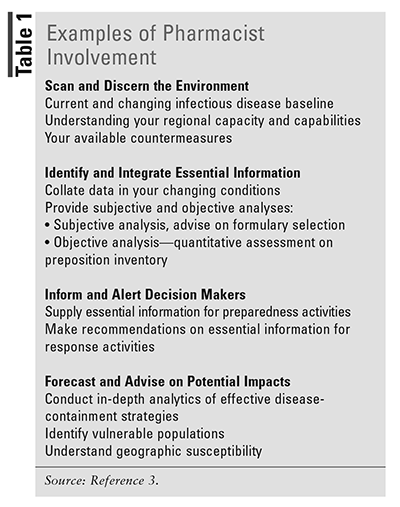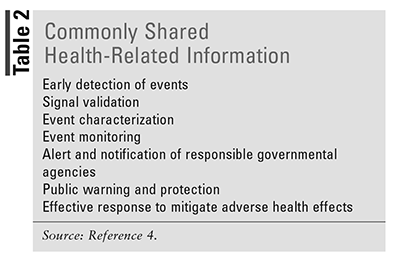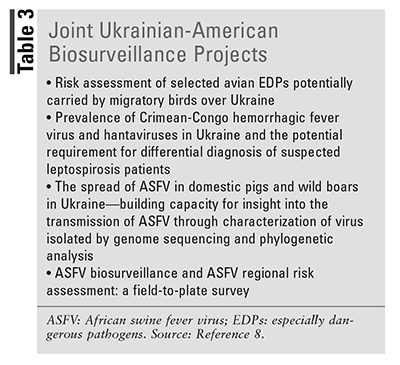US Pharm. 2022;47(9):32-34.
ABSTRACT: Biosurveillance is a relatively new term of international importance. All pandemics, mass casualties, and disease outbreaks start as a local event and present themselves to the community healthcare providers for intervention. Healthcare providers are an integral part of the solution process. On a broader scale, biosurveillance is a recently evolving disciplinary science of real-time disease outbreak detection, which can discover both natural and manmade epidemics as stated in the 2020 Handbook of Biological Warfare Preparedness by Nagaraajan et al.
As distant and unlikely as a chemical or biological event may seem to the profession of pharmacy, we should employ our pharmacy experiences gained from COVID-19 to further understand the demands of the future in a conflicted world.
Homeland Security
The U.S. Department of Homeland Security was created to safeguard our country as well as our world. Events in other parts of our globe soon become our threat, whether natural or man-made. As the Department of Homeland Security must protect us, it has employed several programs that involve many civilian activities. The chemical and biological threat preparedness program is designed to improve threat awareness, advanced surveillance, and early detection, as well as responsive counter measures. As chemical and biological attacks pose a significant threat, healthcare providers, including community and health-systems pharmacists, are viewed as frontline troops both in detection and treatment.1
Biosurveillance
In 2012, the national strategy of biosurveillance was created to streamline and further reduce the gap in surveillance and delivering an early warning of a potential terrorist attack or infectious disease outbreak. Delays in identification of pathogens have created a breakdown in bottom-up multiple sector communication. The National Syndromic Surveillance Program was created to collect and coordinate with the CDC to serve as a community-based and community-driven effort of data collection. The procedure is to use clinical data from hospitals, pharmacies, emergency departments, and public health departments to improve situational awareness. Pharmacists have a seat at the table (see TABLE 1).2,3

Syndromic Surveillance
Biosurveillance is important to increase awareness of emerging infectious diseases and potential bioterrorist attacks. Since approximately 70 pathogens emerged between 1967 and 2009, with a majority of these microorganisms making the jump from their zoonotic host into humans, a secondary system entitled Syndromic Surveillance was implemented with a focus on health-utilization patterns, as in health-related data collection reporting. Sources include clinical laboratories, pharmacies, emergency rooms, primary care physicians, intensive care units, and hospital admission and discharge data. Biosurveillance and syndromic surveillance work together for early detection of deadly pathogens to lessen the risk of morbidity and mortality to individuals, communities, and economies. One of the most important components of intradepartmental information sharing is complete trust. Trust provides the confidence needed both within the U.S. and in foreign nations to correctly address a pending outbreak (see TABLE 2).4

Current Potential Interventions
As healthcare professionals, our focus is always on positive patient outcomes. We must acknowledge that bioterrorism is a perfect vehicle for unethical governments and/or terrorists to create fear, death, and economic destruction. All healthcare professionals need to be prepared for these possible catastrophic events.
Evidence has proven that the Russian Federation is willing to resort to using its huge arsenal of biological armaments within the concept of offensive biological warfare. As noted in the 1999 book Biohazard, the Russian Federation has focused on the production of dozens of weaponized strains of viruses.5 The Russian government does not classify its program as weapons of mass destruction but rather as a means that can be used locally to achieve certain military-political goals, creating necessary consequences for winning tactical victories in low-to-medium intensity conflicts.6
Hybrid warfare as a revision of Russian military doctrine employs nuclear, biological, and chemical (NBC) weapons on a tactical and operational level. There has never been a gradual priority shift in the NBC triad, as nuclear was number one; now, biological has taken the top billing. One plain example of priority shift is simply that the Russian NBC officer curriculum has dedicated more class time and subject matter to biological issues. Biological agents are more difficult to detect and are also similar to various common infectious diseases. A case study of Russian involvement within the Syrian civil war has been proven, including chemical weapons use over a short period with a locally restricted area with controlled access. These tactics are aimed to prevent detection and direct culpability. Similar tactics can be applied to biologic weapons.7
The Russian Federation, under the direction of President Putin, has developed a hybrid warfare doctrine that incorporates limited biological and chemical tactical options. Such actions, regardless of limited operation, shall cause death to civilians and military personnel from terrible diseases and threaten all of mankind.
In a discussion of biosurveillance, we must make the distinction between detection, surveillance, identification, and product research or production. Russia has identified a network of biolaboratories within Ukraine. These laboratories, which began under the Obama-Biden administration and were established under humanitarian pretenses of the Nunn-Lugar Cooperative Threat Reduction Program, continue to be funded and assisted by the U.S. government.8
The biological threat reduction program and the current concept of biosurveillance have many similar characteristics. The U.S. Department of Defense’s Biological Threat Reduction Program collaborates with partner countries to counter the threat of outbreaks (deliberate, accidental, or natural) of the world’s most dangerous infectious diseases. The Biological Threat Reduction Program seeks to develop a biorisk management educational protocol; coordinate an international research partnership; incorporate a goal of enhanced biosecurity; create a culture of bio safety; and cross-train all partners in biosurveillance measures.9
The Ukrainian Biological Threat Reduction Program was prioritized to identify and secure threatening pathogens and dangerous toxins. The Ukrainian mission statement shall continue to be to detect and report outbreaks created by dangerous pathogens before they become a security or stability threat, truly a defensive position in the world of biochemical warfare resulting in a joint effort for detection and response.
It is clear to conclude that Ukraine has no desire to use either biological or chemical weapons in an offensive fashion. It truly would be counterproductive to face off with the Russian Federation, which could retaliate with superior weapons both in quality and quantity. The standard Ukrainian–U.S. agreement is strongly based on defense detection surveillance (see TABLE 3).8 Ukrainian biological research facilities have no production or weaponization capacity, but it does not take much to fuel suspicions of evil intent, and once accusations of actual biological warfare attacks are made, they are difficult to deny.

COVID-19 and Beyond
As we have all experienced the death and disruption of normal life caused by the COVID-19 pandemic, future infectious diseases will emerge with limited or no warning. Our response must be placed on the importance of total global cooperation based on a standardized uniform effective biosurveillance system. Our ability and capacity to detect and respond to infectious disease outbreaks will strengthen both biosurveillance and research capabilities to identify and create medical therapeutic courses of action. The sustained collaboration within the threat reduction research network as in the current Ukrainian biolaboratories will only build trust among countries and their scientific community. The clinical data collected from the frontline healthcare providers, hospitals, pharmacies, poison control centers, and public area health agencies of all nations at any time will allow a full spectrum of data. By compiling the intelligence data, we will improve our situational awareness as well as our ability to monitor specific conditions.
Detecting transmittable diseases and potential biological weapons of war is a formidable task. We must maintain our pharmaceutical capacity and develop alternative therapeutic pathways to address both the quantitative and qualitative challenges of a mass casualty event. Hospitals and community-based pharmacies will be asked to promptly provide antidotes, antibiotics, antitoxins, and other drugs in large quantities. Pharmacists should also have the knowledge of specific drug therapies in reference to biological and chemical agents.1 They should share their knowledge on what to do and how to do it prior to such an event. With global unity against emerging diseases, we shall assist with global health security with cooperative engagement programs, saving time, resources, and eventually lives.
REFERENCES
1. Bennett J, Mandell D, Blaser MD. Bennett’s Principles and Practice of Infectious Disease. 9th ed. Elsevier; 2019.
2. Burda AM, Sigg T. Pharmacy preparedness for incidents involving weapons of mass destruction. Am J Health Syst Pharm. 2021;58(23):2274-2284.
3. Allen KC. Applications: Biosurveillance, biodefense, and biotechnology. In: Horney JA, ed. Disaster Epidemiology. Academic Press; 2018.
4. CDC. Biosurveillance: smart investments for early warning. www.cdc.gov/washington/testimony/2010/t20100225.htm.
5. Alibek K, Handelman S. Biohazard: The Chilling True Story of the Largest Covert Biological Weapons Program in the World–Told from Inside by the Man Who Ran it. Delta; 1999.6. Leitenberg M, Zilinskas RA. The Soviet Biological Weapons Program: A History. Harvard University Press; 2012.
7. Fedorov LA. Soviet Biological Weapons: History, Ecology, Politics. Editorial URSS; 2013.
8. Toledo A. Biological Warfare. 2022.
9. U.S. Embassy in Ukraine. Biological Threat Reduction Program. https://ua.usembassy.gov/embassy/kyiv/sections-offices/
defense-threat-reduction-office/biological-threat-reduction-program. Accessed August 11, 2022.
The content contained in this article is for informational purposes only. The content is not intended to be a substitute for professional advice. Reliance on any information provided in this article is solely at your own risk.
To comment on this article, contact rdavidson@uspharmacist.com.






